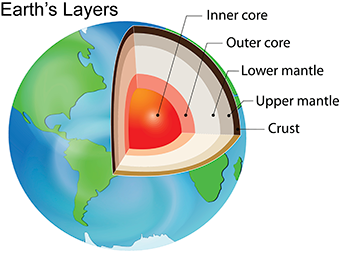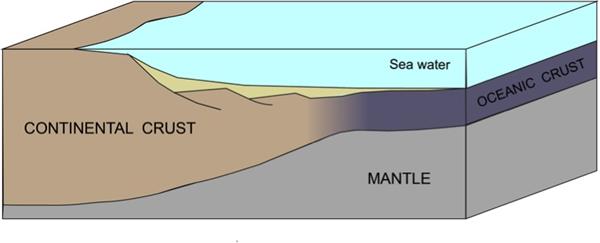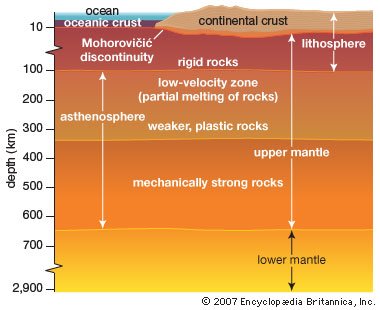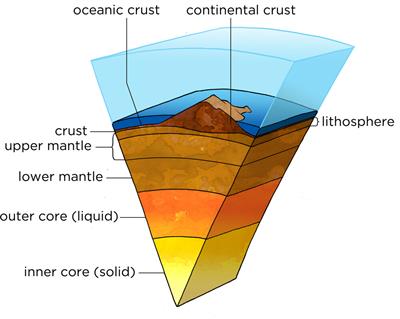PDF chapter test TRY NOW
Introduction:
The origin of Earth and the universe is completely understood and accepted, that the universe began with a cosmic event called, the \(Big\ Bang\). First and foremost, the earth is the only planet that supports lives of all forms. It is the third planet from the Sun by its position and the fifth largest planet by its size and mass. The age of the Earth is over \(4.5\)\(billion\) years, and the shape represents a rough sphere (named as Geoid). The diameter of the Earth is about \(12,740\) \(kilometres \) and its mass is about \(5.97×10^24\) \(kilograms\).
The highest point is Mount Everest of the Himalayas, with \(8,848\) \(metres\) above the sea level, and the lowest point is Mariana Trench of the Pacific Ocean, with \(11,034\) \(metres\) below the sea level.
Interior of the Earth
The interior of the earth is made up of layers which can be explained through either by its mechanical or chemical properties.
- Mechanically (Structure): Earth can be split into the lithosphere, asthenosphere, mesosphericmantle, outer core, and inner core.
- Chemically (composition): Earth can be split into the crust, the mantle (upper and lower mantle), and the core (outer core and inner core) (\(Fig. 1\)).

\(Fig. 1\ \)– The Layers (Strata) of the Earth’s Interior
i) The Crust
The crust is the outermost layer of the Earth, consists of a broad mixture of rock types. The average thickness of the crust ranges from \(6.5\) \(kilometres\) (Oceanic crust - under the oceans) to \(35\)\( kilometres\ \)(Continental crust - under the continents). The temperature of the crust in the desert regions might be as hot as \(35°\)\(Celsius\), and in the Arctic and Antarctic, it would be below freezing point.
Continental crust tends to be much more variable in composition like silicate and aluminium rocks – granitic type (SIAL - Lower in density with \(2.7 g\)\(/\)\(cm³\). The oceanic crust is typically composed of silicate and magnesium igneous rocks - basaltic type (SIMA - higher in density with \(3.5 g\)\(/\)\(cm³\).
However, the crust can be further divided into upper and lower layers. SIAL refers to earth crust's upper layer, made up of silicate and aluminium based minerals. SIMA refers to the earth crust's lower layer with an abundance of silicate and magnesium minerals.

\(Fig. 2\) – Cross-section of Continental and Oceanic Crusts
ii) The Mantle
The mantle is the Earth’s layer that lies between crust and core. Below the crust, a narrow zone with a change in mineral composition is called the Mohorovičić (Moho) discontinuity, which separates crust and mantle. The mantle extends downward to a depth of approximately \(2,900\) \(kilometres\) from the Moho discontinuity and makes up a volume of \(84\%\) of the total (two-thirds of Earth’s total mass; half the distance from the surface to the centre of the Earth). Further, the mantle is divided into two parts as Upper mantle and Lower mantle (\(Fig. 3\)).

\(Fig. 3\) – Cross-section of Earth's Layers (Crust to Lower Mantle)
The upper mantle is relatively thin but stiff and rigid. The average thickness of this layer is \(600\) \(kilometres\), extending down to a depth of \(650\) \(kilometres\) from the Moho discontinuity (deeper under the continents than under the ocean floors). The layers' upper mantle and crust together are called the Lithosphere. The temperature near the crust ranges from \(480º\) \(Celsius\) to \(870º\) \(Celsius\), and it increases towards the greater depths.
The lower mantle is hotter and denser than the upper mantle. The thickness of the lower mantle is about \(2,200\) \(kilometres\) beneath the crust. As a result, the lower mantle is less malleable than the upper, and the extreme pressure retains the lower mantle solid. As a result, a greater variation of temperature in the mantle ranges from \(1000°\)\(Celsius\) (near the crust) to \(3700°\)\(Celsius\) (near the core).
iii) The Core
The core and mantle are separated by a layer called Weichert–Gutenberg Discontinuity. The core is a ball-shaped layer with a thickness of approximately \(3,400\) \(kilometres\) beneath the mantle. Further, the core is divided into two layers as outer core and inner core. It is dominantly made up of nickel and iron (also called NIFE). These two zones together make up about \(15\%\) of Earth’s volume and \(32\%\) of its mass.

\(Fig. 4\) – Cross-section of Earth’s Interior
The outer core is a liquid and made up of liquid metals (nickel and iron). Here, the temperature ranges from \(2,204°\)\(Celsius\) to \(4,982°\)\(Celsius\), and the depth is about \(2,900\) \(kilometres\) to \(5,150\) \(kilometres\) below the inner mantle.
The inner core is solid and made up of solid metals (nickel and iron). The maximum temperature of the layer is \(5,400°\)\(Celsius\), and the thickness ranges from \(5,150\) \(kilometres\) to \(6,370\) \(kilometres\) below the outer core.
